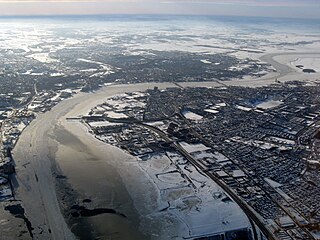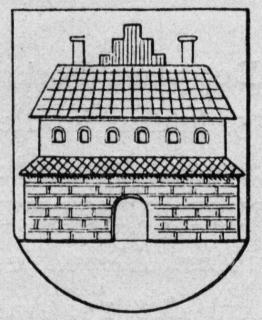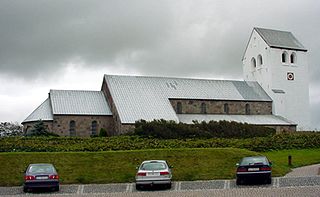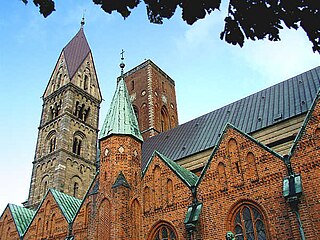History
Vestervig is located inside the Limfjord near the west coast where the Limfjord meets the North Sea. There are many bays (Danish:vig) which branch off the main channel of the Limfjord. Vestervig was an important trading location in Viking times.
About 1030 Saint Thøger settled at Vestervig and built the first wattle and clay church in Thy (now Thisted County). Thøger (or Theodgar) was a Thuringian missionary who had been living in England when Olaf II went there on a Viking expedition. Thøger's wonderful sermons brought an invitation to return to Norway with Olav as his personal chaplain. He had, even as a young man, a reputation for being able to heal the sick. He became a personal advisor to Olaf II. When Olaf was driven from Norway in 1028, Thøger went with the king eastward into Sweden and as far as Kiev. Olaf returned to Norway in 1030, raised an army and tried to take the throne again. He was killed at the Battle of Stiklestad 29 July 1030. Olaf was locally canonized as Saint Olaf. Thøger fled Norway and settled at Vestervig. He began to teach the local people about Christianity without much success.
One night he slept on the ground at the Vestervig marketplace. In the morning where his head had been, a spring began to run. The Danes counted this as miraculous and soon Thøger had his congregation. A church was built near the spring and even in the 19th century people drank water from the spring hoping to cure ailments. One did not have to visit the spring in person, if health prevented it, just to drink the water was enough.
One day Thøger visited a nearby farm called Randrupgård where he met a man standing at his doorway complaining about his bad luck with livestock. Thøger replied, "Put up the cross of Christ where here none has stood before, so will your luck improve!" Immediately a spring burst out of the ground on the spot and people flocked to it for its restorative properties. A cross was raised at the site everafter.
After his death, 24 June 1067, a delegation from Vestervig went to Bishop Albrik in Viborg to have Thøger beatified. At first the bishop was sceptical, but later was convinced and endorsed the process whereby Thøger was declared a local saint. (This was before saints were approved by the curia in Rome.) King Svend Estridsen objected since Thøger had been a close advisor to his old enemy Olav II. On 30 October 1117 Thøger's remains were moved inside the church for the veneration of the faithful. But the story doesn't end there. Thøger made one final appearance. He appeared to the priest of the church the night of his translation into the church dragging one of his legs. He explained that one of his bones had not been included in the reliquary; it was still buried in Thøger's old grave. The next morning the grave was opened and just as Thøger had said one of his leg bones had been overlooked. It was dusted off and placed inside the reliquary and Thøger didn't bother the priest again.
The abbey church and Vestervig church with the sacred spring were both dedicated to Saint Thøger and were locally important as pilgrimage sites. Thøger's fame as a healer spread far beyond Thy.
Vestervig became the seat of the Bishop of Vestervig (later Børglum) in 1059 when Vendsyssel (Jutland above the Limfjord) was created as its own diocese after the death of Bishop Val. Thøger was named the patron saint of the diocese.
The Augustinian Canons who established themselves at Vestervig no later than 1140, were instrumental in the establishment of the Børglum Abbey which later supplanted Vestervig as the seat of the diocese. They were probably immigrants from England. The western end of the Limfjord had filled in making it impossible for ships to sail through the fjord from the North Sea. International trade virtually stopped. One reason for the transfer of the see to Børglum may have been to access the coast easier.
Augustinians were not ordinary monks. They were priests who had accepted the vows of poverty, chastity, and obedience. They lived simply and their work was teaching, helping the poor and sick, preaching the word of God as well as attending services for prayer and song. Their habit was simple white with a black apron or scapular.
The Augustinians built a new church in the 13th century out of large red brick, the most common building material of the time.
Legend has it that one of the canons from Vestervig Abbey kidnapped the wife of a local farmer. The wife escaped and ran back home to tell her husband about the abduction. The farmer grabbed an axe and headed for the abbey. He found the canon at his prayers in the church and struck him a blow so hard that blood spattered across the floor of the church. Ever after the bloodstains remained on the church floor and even when the flooring was torn up and replaced the stains appeared in times of trouble for the region.
There was a nunnery at Kappel near Vestervig Abbey, and rumor had it that the monks built a tunnel that ran from the abbey to the nunnery, so that the canons could move back and forth without being seen. Local histories cite claims of brick work found under fields between the abbey and Kappel as evidence for the tunnel, but no serious excavations have been undertaken to prove or disprove the old story.
The abbey was dissolved in 1536 when Denmark became officially Lutheran. The monks either put off their habits and became local residents or left the country, perhaps south into Germany. The abbey became crown property and the properties which over the years had become part of the abbey estate were sold or given away. Several land owners purchased or inherited the property from that time.
Most of the abbey was destroyed by a fire in 1703. The story goes that a ship stranded on the coast Christmas Eve and Peder de Moldrup/Mollerup, the miserly owner of the buildings of the abbey, received most of the salvage from the wreck. As valuables were forcibly taken from the captain, he blurted out "if our Christmas Eve is so terrible, then your New Year's Eve shall be worse." A store of paper found on the beach was hung out in the loft to dry. Moldrup's wife went to check on it on New Year's Eve, and the flame from the candle set the paper alight and the old abbey buildings, except the church, went up in flames. The sea captain's prophecy fulfilled.
After the destruction of St. Thøger's Church in 1752, the abbey church became the parish church for the town of Vestervig. The church tower has two bells still in use from the abbey days: one cast in 1513 by Sven Andersen and the other cast by an unknown bell maker from the 15th century.

St. Canute's Cathedral, also known as Odense Cathedral, is named after the Danish king Canute the Saint, otherwise Canute IV. It is a fine example of Brick Gothic architecture. The church's most visited section is the crypt where the remains of Canute and his brother Benedict are on display.

Olaf II Haraldsson, later known as Saint Olaf, was King of Norway from 1015 to 1028. Son of Harald Grenske, a petty king in Vestfold, Norway, he was posthumously given the title Rex Perpetuus Norvegiae and canonised at Nidaros (Trondheim) by Bishop Grimkell, one year after his death in the Battle of Stiklestad on 29 July 1030. His remains were enshrined in Nidaros Cathedral, built over his burial site. His sainthood encouraged the widespread adoption of Christianity by Scandinavia's Vikings/Norsemen.
Canute IV, later known as Canute the Holy or Saint Canute, was King of Denmark from 1080 until 1086. Canute was an ambitious king who sought to strengthen the Danish monarchy, devotedly supported the Roman Catholic Church, and had designs on the English throne. Slain by rebels in 1086, he was the first Danish king to be canonized. He was recognized by the Roman Catholic Church as patron saint of Denmark in 1101.
Nidaros, Niðarós or Niðaróss was the medieval name of Trondheim when it was the capital of Norway's first Christian kings. It was named for its position at the mouth of the River Nid.

The Limfjord is a shallow part of the sea, located in Denmark where it has been regarded as a fjord ever since Viking times. However, it has inlets both from the North Sea and Kattegat, and hence separates the North Jutlandic Island from the rest of the Jutland Peninsula. The Limfjord extends from Thyborøn Channel on the North Sea to Hals on the Kattegat. It is approximately 180 kilometres long and of an irregular shape with numerous bays, narrowings, and islands, most notably Mors, and the smaller ones Fur, Venø, Jegindø, Egholm and Livø. It is deepest at Hvalpsund.

Canons regular are canons in the Catholic Church who live in community under a rule and are generally organised into religious orders, differing from both secular canons and other forms of religious life, such as clerks regular, designated by a partly similar terminology.

The Diocese of Skara is the oldest existing diocese in Sweden, originally a Latin bishopric of the Roman Catholic church, and since Protestant reformation a Lutheran diocese of the Church of Sweden, with its seat at Skara in Västergötland. In 2014, it celebrated its 1000-year anniversary as a full diocese.
Erling Skakke was a Norwegian Jarl during the 12th century. He was the father of Magnus V, who reigned as King of Norway from 1161 to 1184.

Børglum is a Danish village with a population below 200 in Hjørring municipality, Region Nordjylland.

The former Diocese of Børglum was a Roman Catholic diocese in Northern Jutland, Denmark. It has also been referred to as the Diocese of Vestervig or the Bishopric of Vendsyssel. The diocese included Vendsyssel, Hanherred, Thy, and Mors.

Vestervig is a village in Vestervig Parish in Denmark, located in Thisted municipality in North Denmark Region. Vestervig has a population of 600. It has a disproportionately large church, Vestervig Abbey, which served as a cathedral until 1130 when the see was transferred to Børglum.

The Christianization of Scandinavia, as well as other Nordic countries and the Baltic countries, took place between the 8th and the 12th centuries. The realms of Denmark, Norway and Sweden established their own Archdioceses, responsible directly to the Pope, in 1104, 1154 and 1164, respectively. The conversion to Christianity of the Scandinavian people required more time, since it took additional efforts to establish a network of churches. The Sami remained unconverted until the 18th century. Newer archaeological research suggests there were Christians in Götaland already during the 9th century; it is further believed Christianity came from the southwest and moved towards the north.

The former Diocese of Ribe was a Roman Catholic diocese in Southern Jutland, Denmark. The diocese was established in 948, and dissolved in 1536 during the Protestant Reformation. Within the newly established protestant Church of Denmark, the Diocese of Ribe effectively replaced its Roman Catholic precursor.

Thy is a traditional district in northwestern Jutland, Denmark. It is situated north of the Limfjord, facing the North Sea and Skagerrak, and has a population of around 44,000. The capital is Thisted. Snedsted, Hanstholm and Hurup are minor towns in the area.

Børglum Abbey was an important Premonstratensian abbey of medieval Denmark, located in Børglum parish, in the commune of Hjørring, approximately five kilometers east of Løkken in north central Jutland between the 12th-century until reformation.
Asmild Abbey was a house of Augustinian canonesses with a close connection to the Augustinian canons at Viborg Cathedral in north central Jutland, Denmark from 1165 until reformation.

The Archdiocese of Nidaros was the metropolitan see covering Norway in the later Middle Ages. The see was the Nidaros Cathedral, in the city of Nidaros. The archdiocese existed from the middle of the twelfth century until the Protestant Reformation.

Æbelholt Abbey was an Augustinian monastery situated at Tjæreby in Hillerød municipality in North Zealand, Denmark.
Theodgar of Vestervig was a missionary from Thuringia who worked mostly in Jutland in Denmark, where he died and is venerated as a saint.
The history of Christianity in Norway started in the Viking Age in the 9th century. Trade, plundering raids, and travel brought the Norsemen into close contacts with Christian communities, but their conversion only started after powerful chieftains decided to receive baptism during their stay in England or Normandy. Haakon the Good was the first king to make efforts to convert the whole country, but the rebellious pagan chieftains forced him to apostatize. Olaf Tryggvason started the destruction of pagan cult sites in the late 10th century, but only Olaf Haraldsson achieved the official adaption of Christianity in the 1020s. Missionary bishops subjected to the archbishops of Hamburg-Bremen were responsible for the spread of the new faith before the earliest bishoprics were established around 1100.














